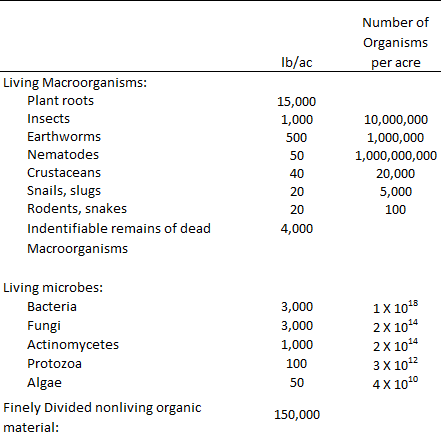Soil is a complex array of mineral material, air/water and organic matter. Organic matter itself is composed of three basic types: living organisms (microorganisms, earthworms, insects etc), recently dead (micro, plant, and animal), and very dead components (humic substances). There can be a wide range of organic content distribution among various soil types:
“Organic matter constitutes from 1 to 6% of the topsoil weight of most upland soils. Topsoils with less than 1% organic matter are mostly limited to desert areas. At the other extreme, the organic matter content of soils in low wet areas may be as high as 90% of more. Soils with more than 12-18% organic carbon (approximately 20-30% organic matter) are called organic soils.”
Considering the assumption that most soils’ Horizon A contains between 1 and 6% humic acid, this represents between 20,000 and 120,000 lbs of organic matter in an average acre furrow slice (about 2 million lbs of soil). The organic matter in the full solum (horizons A and B) is considered to be 2 to 3 times that of the furrow slice (Franzmeier, Lemme, and Miles 1985). Fresh residues typically represent less than one tenth of the weight of soil organic matter – the rest being Humus. Some consider the difference too small to make any distinction between humus and soil organic matter, others choose to classify the organic materials according to mode of origin:
- Living Macroorganisms
- Indentifiable remains of dead macroorganisms
- Living Microbes
- Finely divided nonliving organic materials (essentially all humus)
The estimated average contents of Organic Materials per acre in a soil profile formed under grass in a subhumid temperate region can be found in the following table:
Table 6-1 (Troeh et al. 2005)
Hopefully, this provides a concise overview of soil organic matter and its constituent parts. Unfortunately, this information provided above is not absolute. Many factors can effect the amount and composition of organic matter (specifically humus), which we discuss further in our Overview of factors effecting humus decomposition. Reference: Troeh, Frederick R., and Louis M. (Louis Milton) Thompson. Soils and Soil Fertility. 6th ed. Ames, Iowa: Blackwell Pub., 2005.


